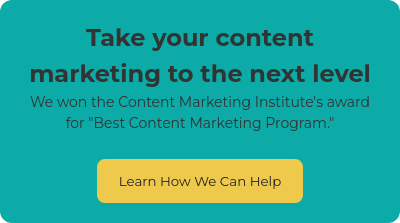Content marketing is identified as one of the most important aspects of a business’s overall marketing strategy. A good content marketing strategy is designed to create and deliver valuable, consistent and relevant content to your brand’s target audience in an effort to get them to visit your business website, purchase your product, sign up for a subscription, read a blog or download a piece of content. Nowadays, brands can deliver content on so many different platforms, such as SnapChat, Twitter, Facebook (posts, stories, messenger), Instagram (posts and stories), messenger bots, LinkedIn, YouTube, Google+, and Reddit to name a few.
But, is it possible for a brand to put out too much content? With all of these online communication avenues, when and how does it all become “too much”? Do we as users want, or have, time to consume content on this many platforms, from all of our favorite brands? And, on the other side, do brands really have the capacity to create fresh content for all of these platforms? I think it can be dangerously easy for brands to burn themselves out by putting out too much content, and too fast. This in turn creates lackluster content that isn’t unique or showcasing thought leadership. I think there are many brands that take that strategy today. And funny enough, it’s a lot of the big brands that have the money to spend on trying to reach their audience on every single technology platform. But, it’s important to understand that as a business, you do not need to use every platform out there to “win.” If you choose one platform, or two, and do it really well, you can create an engaged, loyal audience that consumes and shares your content regularly.
Content Quality Over Content Quantity
If you stop to think about the 1) amount and 2) quality of content you’re putting out, that is the first step to determining if your brand is putting out too much content. For example, writing a blog post for every day of the week, and sharing it over and over again on Twitter, Facebook, Instagram, etc. can be overkill, especially if your strategy isn’t right and your engagement is low. This can also be expensive and time consuming to keep up. Instead of writing one really stellar blog post with 1,500 words or more that completely walks someone through the steps to achieve an interested skill or task, or features smart insights and data it took time for your business to create… your blog posts might just be 700 generic evergreen words that can be found on 100 different websites and will never appear on the first page of Google. Which approach do you think is better? Taking the time to create one blog that makes people go, “WOW, this is so useful, I’m going to share it.” Or posting five blogs that make people say, “Meh, I don’t need to read that,”
Below are three additional questions to ask yourself to help hone in on your content strategy:
-
Is your current content strategy helping your business achieve its goals? For example, if you are trying to raise awareness, are you using the right avenues to cover a larger number of potential customers and generate engagement?
-
Are you sending the right content to the right platform, at the right time? The message you’re sending on Twitter may not be as effective on Facebook. Do your customers visit Facebook for personal updates or news articles? Ensure your content is tailored to the platform and how it’s users absorb information.
-
Is your content helping customers or prospects in some way? Is it relevant enough for the customer to keep coming back for more information? Your content needs to be valuable enough not to feel like it’s clogging their newsfeeds.
Approaching your content strategy at a micro-content level will help your business save time. Micro-content is short form content that is typically at low cost with a high value. For social media, users tend to have a lower attention span. Sending out small bits of useful, concise information to your target audience will help position your business as part of your audiences routine. Information could include tips, updates, etc. that are easy to digest.
Monitor Your Platform Engagement
As the industry continues to add more social websites and apps, it further challenges brands to find space and give attention to the newer platforms, either by way of consuming it or creating it. The connection between brands and consumers has never been higher than it is today. According to Sprout Social, 1 in 3 consumers would mention a brand while sharing a personal message on social media. Your presence on these platforms is pertinent to your brand. That means it's more important now, than ever, to ensure your brand is on the right platforms, sending the right content to the right people to increase engagement. While the definition of engagement can vary platform-to-platform, engagement is typically understood as a like, share or comment on one of your posts.
But, I strongly believe that just because consumers are interacting with brands on social media platforms, you do not need to be on every platform. If we all put ourselves in a consumer’s shoes (because us marketers are consumers too), I doubt you want to hear from a brand when you open Facebook, Twitter, SnapChat, Pinterest, YouTube and Google. This is just too much. If I come across one really good piece of content on one of these platforms during the day, I will remember this and think your brand is cool. If I run into the same post on every platform, all day long, with your brand in my face. I’m going to feel annoyed and likely unfollow a brand, therefore disassociating with positive brand affinity.
Choose a platform you want to be really good at, and spent your time curating an amazing message on this platform. If I had to recommend one platform to businesses, I would choose Instagram. Currently, Instagram is the most engaged social media platform, with 2-7 percent of users interacting with each post. Instagram’s mobile functionality is easy-to-use and right at your fingertips, which is key in this mobile-centric world. Instagram is centered on storytelling, which is a great way for a business to create an emotional connection with its audience. More and more consumers want to feel connected to the brands they purchase from. A unique aspect of Instagram allows you, with the customer’s permission, to use their images for your marketing, so a lot of Instagram’s photos are user-generated content. You can reach a large part of your target audience through the use of relevant hashtags. And don’t forget about the metrics so you can continue to measure your progress and adjust your strategy. Track important engagement metrics such as comments, likes, most-engaged hashtags, followers (engaging and gained), stories metrics (unique views, completion rate, and DMs to your story) and referral traffic.
In general, just because you can blast out content through 15+ different platforms doesn’t mean you should. Focus on utilizing the platforms that your target audience engages with most. Develop your content strategy around valuable, relevant information that your customers want to retain. Create a content calendar to ensure a consistent cadence of content your audience anticipates. Don’t get lost in the noise, remember that quality is crucial to your brand’s success, and whatever you do, just don’t CTMC (create too much content).







